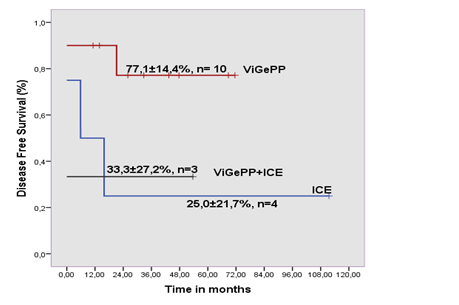eISSN: 2574-9838


Mini Review Volume 3 Issue 5
Hematology/Oncology Department, Institute of Pediatric Hematology&Oncology Cancer Research Centre, Moscow, Russia
Correspondence: Alexander Popa, Hematology/Oncology Department. Institute of Pediatric Hematology & Oncology Cancer Research Centre, Moscow, Russia
Received: August 23, 2018 | Published: September 26, 2018
Citation: Popa A, Belyaeva E, Kulichkina N,et al. High dose chemotherapy with autologous SCT in pediatric Hodgkin’s lymphoma. Int Phys Med Rehab J. 2018;3(5):409-410. DOI: 10.15406/ipmrj.2018.03.00136
The modern programs for treatment children with newly diagnosed Hodgkin’s lymphoma (HL) allow to achieve 10-year event free survival 85-93%, but 7-10% of pts develop relapse and 2-5% are initially refractory to standard chemotherapy even it was really intensive. Besides, there are no any indications for hematopoietic bone marrow transplantation in patients with relapse HL. From July 2003 to August 2017. 35 children with relapse – 18(51,4%) and refractory –17(49,6%) were enrolled to the protocol. From the beginning of protocol to 2007 all the pts got two courses of ICE followed by auto-HSCT Figure 1.
After getting preliminary results of treatment, therapy was shifted on 4 courses ViGePP (Vinirelbine, Gemcitobine, Procarbasine, Prednosone) followed by auto-HSCT. Thus, therapy based on ICE got 14(40%) pts and ViGePP–14(40%), 6(17%) children began getting ICE, but they did not response and therapy was shifted on ViGePP, and one (2,9%) got two courses of ViGePP with stable disease and the therapy was shifted on two courses of ICE. So, overall response rate was 95%, CR2 was in 20(57%) pts, PR–13(38%), progressive disease –2(6%). CR was faster in pts with relapse–66% than in pts with refractory–47% (p=0,04) and PR was definitely less in patients with relapse–27% vs refractory–47%. (p=0,02). CR was definitely higher in patients treated with ViGePP then ICE–86% vs 43% (p=0,021) Table.
DFS of all patients was 69,6%, median follow up–95,7 months, EFS–67,2%. There were no significant different of DFS between relapse and refractory patients –83±8,3% vs 56,5±12,3%, p=0,13. In refractory group DFS was significantly higher for patients treated by ViGePP than two another groups 77,1±14,4% vs 25±21,4% (p=0,047) Figure 2. 28 pts were underwent auto-HSCT with two high doses regimes: 1- Ara-C+Mel for children who got induction ICE and regime 2–VP-16+Mel for pts treated with ViGePP. Median CD34+cells were 4,4±1, 2x106/kg and hematopoietic recovery was on day 11±2,5. None of the patients died after auto HSCT. Hematologic and intestinal were the main types of toxicity. And really much better DFS was in group patients who achieved CR before auto-HSCT. After induction chemotherapy CR was not got in 13 (38%) pts, 5 of them achieved CR after high dose of chemotherapy and 4 from 5 have been alive without progression disease more than 5 years.
Auto-HSCT were not made for 7 pts because two had got progressive disease after two courses of ViGePP, two with early response had got heart failure and lungs fibrosis, one refused from procedure, and two had got very late relapse and achieved CR after the second course of ViGePP. Four patients are still alive, median follow up more than five years. Two patients got brentuximab during second relapse and they were undergone by the second auto-HSCT. They are alive more than 4 years without disease.

Figure 2 Relapse-free survival in children with refractory Hodgkin’s lymphoma in groups with different therapy regimens.
ICE |
ViGePP |
ICE+ ViGePP |
Total |
|
Complete |
6 |
12 |
2 |
20 |
response |
(43%) |
(86%) |
(29%) |
|
Partial response |
8 |
1 |
4 |
13 |
(57%) |
(7%) |
(57%) |
||
Progressive disease |
0 |
1 |
1 |
2 |
(7%) |
(14%) |
|||
Total |
14 |
14 |
7 |
35 |
Table 1 Response to treatment
DFS was higher in patents treated by ViGePP than ICE that’s why ViGePP is more preferable regardless of disease status. Auto-HSCT is very important part of program treatment especially in pts with early relapse and refractory HL even if there was not got CR after induction. Probably children with late relapse of HL needn’t auto-HSCT.
The author declares no conflict of interest.

©2018 Popa, et al. This is an open access article distributed under the terms of the, which permits unrestricted use, distribution, and build upon your work non-commercially.